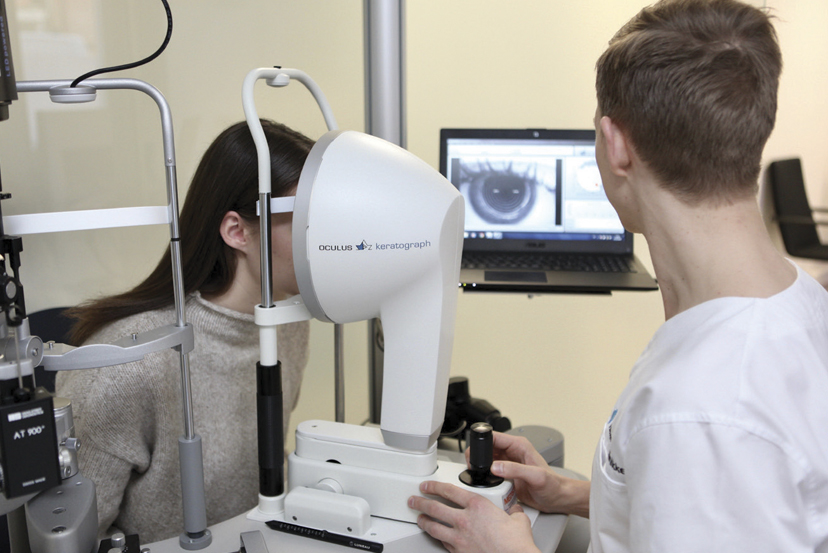
30 Sep HSE measures for better eye health

M.D. Ph.D., øyelege
Sten Ræder
Daglig leder Øyehelseklinikken
– Tørreøyneklinikken

Statsautorisert revisor
Rune Ødegård
Digitalization and increased screen use:
Dry eye is one of the most common and widespread eye conditions in Norway, affecting up to 50 percent of the population to a lesser or greater extent. In this article, we look at how it is possible to ensure the best possible eye health and, among other things, prevent dry eye syndrome, computer vision syndrome, etc.
The tear film is not working properly
The condition involves the tear film, a thin membrane that moisturizes and nourishes the surface of the eye and must be intact for us to see clearly. Dry eye is caused by a disruption in the production of tear fluid and/or lipids and causes the thin tear film to malfunction.
Aging, hormonal imbalance with reduced androgen levels (male sex hormones), cataract and lens replacement surgery, diseases such as diabetes and rheumatism, and medication for high blood pressure and allergies can have a negative impact on the tear and sebaceous glands in the eyelids and thus the function of the tear film.
An inflammatory condition
Dry eye is generally an inflammatory condition caused by tears becoming too salty (hyperosmolar) due to a lack of tear fluid or lipids. When tears become too salty, inflammation of the cornea and conjunctiva can occur, which can cause irritating symptoms such as a sandy feeling, burning and, for some, disabling pain.
Symptoms
Symptoms of dry eyes can include dryness, a sandy feeling, itching, soreness, irritation, burning and pain in the eyes, tired eyes, sensitivity to light and increased blinking frequency. Normally, you blink 8-12 times per minute to moisten the eye. With dry eyes, you compensate by blinking more frequently, i.e. more than 12 times per minute. Other symptoms include: tearing, varying visual acuity and red eyes, as well as discomfort when using screens and contact lenses. The condition can lead to reduced quality of life due to impaired vision, ocular discomfort and, ultimately, disabling pain.
Triggered and exacerbated by lifestyle
Dry eye is a condition that can also be triggered and exacerbated by our modern lifestyle and technological society. Increased evaporation of the tear film as a result of screen use is a common problem and the condition is referred to as Computer Vision Syndrome (CVS). The reason for the increased evaporation is that the blinking frequency is reduced and, in the worst case, halved when looking at screens. It is also unfortunate that blinking is less frequent and incomplete, as blinking is the motor for the secretion of fatty substances from the meibomian glands in the eyelids to the tears.
HSE measures for maintaining good eye health
It is possible to ensure the best possible eye health and prevent dry eyes, computer vision syndrome, etc. by
Adjust the screen, table and chair to the user. Make sure to have 50-70 cm distance between the eye and the screen, angle the screen 15-20 degrees backwards; and leave the center of the screen at a 15-30 degree viewing angle below the horizontal line of the eye. This helps to reduce evaporation of the tear film.
Reduce the brightness of the screen. Avoid/turn off fluorescent lights placed in the ceiling above the monitor and replace this light with a good desk lamp that ensures good light over the keyboard.
Ensure that the light in the room is at the right “temperature”. There is speculation that LEDs with a high color temperature and thus a high blue light content may be harmful to the eyes. The screen should be positioned correctly in relation to any windows. There should be no glare from windows in the screen.
Use filter glasses that absorb the blue light to different degrees, or alternatively turn off the blue light in the PC, e.g. using justgetflux.com/. For smartphones and iPads, it is important to keep these in night mode at all times.
Use artificial tear fluid.
Take frequent short breaks to allow your eyes to recover. The 20-20-20 rule means that every 20 minutes you look at something 20 feet (about 6.5 meters) away for 20 seconds.
Blink often and hard, set a blink reminder/alarm, e.g. a sound combined with the cat “Gardfield’s” big eyes in the top right corner of the screen. There are free blink alarms that can be downloaded from the internet. For example, try the Donald Korb Blink Training app. Here you will also find a blinking exercise.
Ensure that the screen settings are as optimal as possible in terms of contrast, sharpness and the size of numbers and letters, so that the eyes can relax as much as possible and do not have to concentrate.
Check the humidity level
Dry eyes can also occur in/be caused by indoor environments with low humidity and high air flow due to heating and the use of ventilation systems.
Rune Ødegård (58) – my story
I worked in auditing from August 1988 (licensed as a state-authorized public accountant from February 1991) until I went on 100% sick leave in November 2016 due to eye problems. The problems were irritation, dryness, soreness, sandy feeling, high degree of sensitivity to light and major problems with concentration when focusing at close range, etc.
No tears
At the end of 2016 and the beginning of 2017, the symptoms were so bad that I hardly dared to drive a car, and at the funeral of a very dear relative there was not a single tear, which I found very abnormal for me. On sunny days, I had to stay indoors with special filter glasses.
Common to my employers, in all the years I worked in auditing, was a total absence of HSE measures aimed at screen use, lighting conditions, etc. However, two of them paid for the computer glasses of the time. In January 2017, I was on 70% sick leave, but had to work far more than 30% would indicate, i.e. I had to put pressure on already damaged eyes to assist the employer in completing a large assignment within a deadline. The consequence was further aggravation of the eye problems and I was again on 100% sick leave. Since then, I have been on sick leave and on work assessment.
Started with a lot of overtime
The symptoms began in the spring of 2013 after I had worked a lot during the entire annual settlement period, especially in 2012 and the first part of 2013, for example 100 hours of overtime in just one month. I went to my optician for an examination and was given artificial tear fluid for use during the day and eye ointment for use at night.
Surgery and constant examinations
A doctor thought that heavy eyelids could be part of the cause of the symptoms, as they rubbed against the eyes. The eyelids were operated on to no avail and the symptoms gradually got worse, although they improved somewhat during holidays – i.e. when the eyes were free from the screen.
In general, an indoor relative humidity of 20-40% (the higher the better) at a room temperature of 20-22°C is recommended. Simple humidity meters can be purchased at Clas Ohlson, for example. Humidity can be increased by, for example, reducing the fan speed in the ventilation system and using a humidifier for limited periods during the day. If possible, the humidifier can be installed with a thermostat so that it switches on automatically when the humidity falls below the desired level.
Medical devices
There is a wide range of eye drops and other aids to combat dry eyes. Artificial tear fluid is used to lubricate the surface of the eye, dilute the tear film, reduce the concentration of inflammatory substances in the tear film and replace substances that are missing from the tear film.
Blue prescription
If you have chronic dry eyes and the assessment shows that you have reduced tear quality or quantity, you are entitled to medication on a blue prescription. A blue prescription means that the state will cover part of the cost of the medicine. Corticosteroids and cyclosporine are eye drops that inhibit the inflammation and ulceration of the surface of the eye associated with dry eye. Corticosteroids are usually used in the acute phase or when the condition worsens and should only be used for limited periods of time due to the risk of pressure increase and the development of cataracts. Cyclosporine is indicated for moderate to severe dry eye and is used for longer periods of time. For other measures, please refer to the Dry Eye Clinic’s website www.torreoyneklinikken.no.
Visit a pharmacy, optician or oph thalmologist
If you suffer from dry eyes and have problems related to screen use, you should visit a pharmacy, optician or ophthalmologist. Mild dry eye can be treated by an optician, but moderate to severe dry eye should be treated by an ophthalmologist with prescription medication.
I was constantly examined by opticians, GPs, public and private ophthalmologists and optometrists. They gave me various eye drops, eye ointments and heat treatment of the eyelids, but none of them could give me the right help and none of them understood what was going on. In addition, none of them were humble enough to refer me to someone with the right expertise. However, I was given a tip to contact the Dry Eye Clinic in Oslo, and treatment started there on January 24, 2017. The Dry Eye Clinic is the only specialist clinic in the Nordic region for the treatment of dry eye or eye allergy and has helped to write the guidelines for dry eye treatment for general practitioners.
A chronic and lifelong diagnosis
When I arrived, I was thoroughly examined by Sten Ræder to see if there were any underlying diseases or other conditions that could explain the development of my symptoms. No underlying diseases etc. were detected. However, the results of all the eye examinations enabled Sten Ræder to make the following diagnosis: Computer Vision Syndrome, cicatricial Meibomian gland dysfunction (MGD) with up to 75% loss of glands in the eyelids, corneal nerve damage, inflammation on the surface of the eyes, severely reduced tear production, abnormally high degree of sensitivity to light, etc. The condition is chronic and lifelong.
Better, but disabled
After following the treatment program at the Dry Eye Clinic for over four years, I have gradually improved and dare to drive a car again, even if I have to stop to drip my eyes and take a break after plus/minus one hour. I can go outside again when the sun is shining, as long as I wear strong filter glasses. I get tears in my eyes again when there is really something to cry about, and I can read a few pages in a book, go online banking and write shorter emails before the pain in my eyes comes. This means that I can now focus for a few minutes at a time, but then have to take long breaks. Everyday life has improved significantly, although my eyes are better off, but I’m still very much disabled.
1. find an employer who thinks long-term and prioritizes HSE measures to ensure good eye health. If necessary – demand such measures, and if they are not implemented, change jobs.
2. to your employers: put satisfactory HSE measures with regard to screen use and eye health high on the priority list, and introduce good measures as soon as possible.
3. if you experience similar problems as me, contact the best eye specialists the sooner the better. You may also want to contact a skilled optician who can help you with customized filter glasses and scleral contact lenses. These glasses and lenses can be covered by NAV, and the optician will help you apply for this.


No Comments